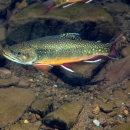Featured Species
The refuge was established for the conservation of migratory birds and federal trust species, and the habitats they depend on. The lands and waters of the Cherry Valley have been widely recognized for their valuable natural resources. These include a diverse mosaic of wetland and upland habitats that support an unusually large number of federal trust species, including five federally listed threatened or endangered species. The Kittatinny Ridge (which flanks the south side of the valley) has been designated an Important Bird Area by the Pennsylvania Audubon Society, and is a well-known migration flyway that concentrates up to 20,000 migrating raptors and more than 140 bird species every fall. Large blocks of unfragmented forest along the ridge also serve as valuable breeding areas for interior-forest birds.
Bog Turtles
Cherry Valley National Wildlife Refuge was established in part to protect the federally threatened bog turtle, which can be found in wetlands throughout the valley. Due to their listed status, refuge public use areas are located away from sensitive bog turtle habitats.
Migratory Birds
The Kittatinny Ridge (which flanks the south side of the valley) has been designated an Important Bird Area by the Pennsylvania Audubon Society, and is a well-known migration flyway that concentrates up to 20,000 migrating raptors and more than 140 bird species every fall.
Mammals
The most well-known mammal species in Cherry Valley are game animals, including black bear and white-tailed deer. Squirrel, raccoon, woodchuck, skunk, and opossum are found in the more developed areas of the watershed. Common furbearers include mink, muskrat, beaver and otter.
Forested Ridges
The valley’s ridges and hills are cloaked in mixed hardwood and conifer forest, while chestnut oak, gray birch, quaking aspen, white pine, and pitch pine populate flat ridge tops once cleared for pasture and logging. Some juniper and Virginia pine can be found on recently abandoned farmland. Oaks, red maple, black cherry, hemlock and tulip poplar dominate in other areas. These upland forests are the most common habitat type and total nearly 18,800 acres, nearly 60 percent, of the valley.
Rivers, Streams, and Wetlands
In most areas of the valley, riparian riparian
Definition of riparian habitat or riparian areas.
Learn more about riparian vegetation is well‐established and stable, providing a thick canopy important to fish. In addition to streams and creeks, a variety of forested and open wetlands are found in the valley bottom and total nearly 1,750 acres. These wetlands host a variety of wildlife including waterfowl, wading birds, river otter, beaver, and several dozen species of reptiles and amphibians. Vernal pools are also scattered across the valley, supporting a number of salamander, frog, turtle, and snake species.



